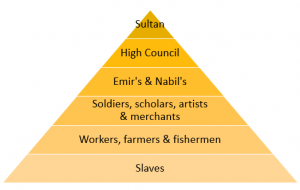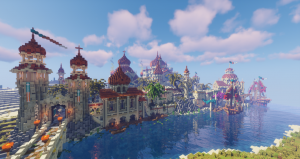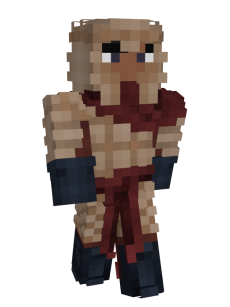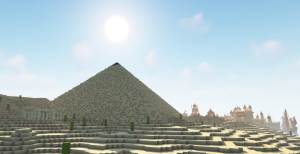The Empire of Anjyarr
| Capital | Al-Khadir |
| Location | Anjyarr |
| Races | Dark Elves |
| Primary Religions | Cult of Fineall |
| Political System | Elective Aristocracy |
| Current Leader | Sultan Sig'vyl Al-Buthara |
| The High Council | - |
| Preceded by: | |
Introduction
At the mouth of the great Ifriq delta lies the emirate of Al-Khadir, capital of the great Empire of Anjyarr. It is a paradise of great wealth and prosperity in the midst of an unruly wasteland. Founded by a tribe of nomadic traders, whom settled due to the pleasant climate and geographic location near the Ifriq, Al-Khadir quickly became a trading hub for races all around the world. The city is a gateway to anyone wishing to enter the Southern world. It offers a large market for all kinds of goods, from elven trinkets to dwarven drinks, but also an extensive range of local wares such as tobacco, carpets, coffee, spices, and garments!
Geography
The Empire of Anjyarr encompasses the entirety of the Anjyarr desert and the volcanic Jabridian island. In the south, the nation's border is signified by an extensive mountain range, the southern Spine of Eden, which functions as a natural line of defense. On the other side of the Spine lies the neighboring plains and Jungle of Spiders. The Anjyarri desert has little to no mountainous terrain and thus offers no defense from invaders from the east. Only the far eastern canyons that cover the biome's border and the realm housing the Valley of Kings provide natural security due to its narrow pathways. The Empire's capital Al-Khadir lies at the estuary of the great Ifriq delta, functioning as a trading port and a gateway to the Alban Ocean.
The nation's second-largest city, Al-Jabrid, is located on the Jabridian island, not far from the coast of the Heartlands. Due to volcanic activity under the sea level thousands of years ago, an island was formed, rich in Black Iron minerals. The island's steep elevation from the seafloor makes it near impossible to access, and the citizens of the island city have used this to great advantage. The island was eventually connected to the mainland via bridges connecting to the watch fortress of Ceril's Keep.
Culture and Society
Apparel
Despite the many differences between the two races, the Khadan Humans and the Dark Elves have developed a common trend in apparel. The harsh climate of Anjyarr has made both races favor loose, layered robes and dresses made out of many different materials, such as cotton, linen, silk, or satin. The wealthy often wear clothes accessorized with various jewels, usually made of precious metals such as gold or silver. The robes and dresses of the Khadan are generally very colorful and often have accents of gold woven within the fabric. The only difference between the two races regarding their apparel is that the elves prefer elegant dark-colored robes decorated with mostly purple gems and inlaid with silver instead of gold. It is also usual for Khadans to wear piercings or cover their bodies in decorative body paint, a custom originating from their nomadic past. While traveling through the desert of Anjyarr, the Khadan are often seen wearing hoods over their heads as protection as well as to hide their identity. On top of that, the women are often noticed wearing veils covering their faces in order to keep the sand out of their faces and prevent it from reaching their eyes.
Social hierarchy
The foundation of Anjyarr's society is an apparent social hierarchy bound by profession. The Sultan stands at the top of this hierarchy, followed by government officials such as the high council, the Emirs, and the various Nabils. These groups make up the upper class of Anjyarr's society.
The middle class consists of soldiers, scholars, merchants, and artists. These people form the core of Anjyarr's society. They are the intellectuals, the cultural backbone, and ultimately the ones that can be chosen for a position in the high council should the need for inevitable successors arise.
The lower class consists of workers, farmers, and fishermen. They are the driving force behind Anjyarrs economy and are made aware of this from a young age. Discrimination against those of lower class is therefore next to unknown in Anjyarr. Each citizen of the Empire knows that without the participation of other classes, they cannot exist and thrive. It is from this class the notorious art of weaving and its artisans come from.
There is, however, an exception: this being the lowest class in Anjyarr, the slaves. Slavery is still practiced in Anjyarr due to the regional climate and history of the realm. Many people struggle with working in the intense heat, which is why slaves are used for hard labor in the burning sun. This class mainly consists of foreign prisoners and criminals that have been sold to the Empire for punishment.
In the past, enslaved people were also obtained through prisoners of war or as loot from raids by the many desert tribes or on neighboring realms. Yet, since the reliability began slowly changing, and slaves no longer became a vital currency, they reverted to criminals and prisoners instead. However, even slaves are able to climb up the social hierarchy. When an enslaved person shows he can be trusted and behaves well, over time, said slave can buy his freedom and become a member of Anjyarrs lower class.
The use of slaves by the Empire has been criticized by many for being inhumane, as Anjyarr remains one of the last nations on Eden to use them. The peoples of Anjyarr care little for this matter, however. They highly value trust, loyalty, and unity above all. These values and ideals form the backbone of their society, and since most slaves are criminals, they are viewed as traitors to these ideals.
Political structure
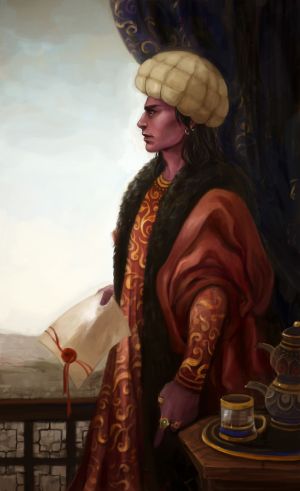
Anjyarr has an elective aristocracy, which means that those with power or riches, or those who are best suited to govern, are placed in charge. These people are known as the high council, a court of representatives. Each member is responsible for representing specific social interests that are vital to Anjyarri society, such as agriculture, architecture, infrastructure, economy, and security. Although the court members serve merely as advisors to its head, the Sultan or Sultana, they have reasonable autonomy regarding their respective fields. Each of them has its own office, scribes, and personnel. Once chosen, council members can stay in office for as long as possible. Council members can also be relieved of their duties when they are no longer deemed fit by the Sultan or other council members. When a council member can no longer perform in their job or role in the council, a replacement can be elected to take his place. These successors hail from society's "Middle" class, mainly scholars. These people will present themselves in front of the people they may have to represent and, with their support, will be brought before the High Council, which will then choose the successor.
If the bloodline of the Sultan ends without an heir, the council members of the High Council are the only ones with the right to vote for a new head of state. Throughout history, it has become common for the next to take over the realm to come from their ranks. Once a Sultan is determined, the family will be the next to become the ruling figures of the Anjyarri desert and the expanding realm. A Sultan and his family can be removed from power either through death or when he is no longer deemed suited for the job by a 3/4th majority of the high council. The Empire is divided into various emirates, decentralized provinces that can thus govern themselves as long as they follow the law and stay loyal to the Sultan, with whom lies the supreme authority. An example of one of these emirates would be the island Emirate of Al-Jabrid. The central government resides in Al-Khadir, the capital of the Empire. They primarily concern themselves with wars, criminal proceedings, taxes, and large-scale infrastructure projects. They also govern the emirate of Al-Khadir.
The desert of Anjyarr is a primarily unclaimed or unchartered territory, often ruled over by certain Emirs in secluded castles or settlements near important and well-known roads and trade routes. However, the desert is inhabited by a large community of nomadic tribes and warbands, who follow a different political system thanks to their culture. Emirs regularly clash with these tribes as they emerge to plunder unprotected merchants of their wealth. Henceforth, the uncharted territories of the desert are often deemed "lawless," and only those in command rule; the nomads.
Commerce and Work
Anjyarr is home to artisans famous throughout Eden: musicians, sculptors, painters, and many other crafts. Due to this, the capital of Anjyarr, Al-Khadir, has become a continent-wide trading hub where all cultures and backgrounds come together to trade and share their wealth. This allows many artisans to grow in skill and extend their knowledge, sharing and learning from one another. Over the centuries, Anjyarr has grown in popularity for its extensive use of art and song in many of its products, making them stand out from the rest of Eden. Painting, sculpting, and drawing have become extensively familiar in the Anjyarr lands; its roots are still up for debate as the many tombs and ruins spread across the desert leave more questions than answers. People tend to let their bodies tattooed or painted with what they call: Ahahn, which is a Kha'mal nomadic tradition often tied to romance. The body paint and tattoos reflect stories, personality, art, and culture glimpsed throughout the Anjyarri lands. Weaving is a common practice many Khadan perform on the market due to a history of expressing stories and music in fabrics and colors, and thus many styles were developed.
Weaving is an essential part of Anjyarri culture and art, primarily the weaving of carpets. The Anjyarri carpet stands out from its myriad of design variety and elaborateness, and it can be encountered throughout Eden in offices, castles, and palaces. Anjyarri carpets and rugs of various types are woven in parallel by nomadic tribes, village and town workshops, and royal court manufactories alike. As such, they represent miscellaneous, simultaneous lines of tradition and reflect the history of Anjyarr and its various peoples. The art of weaving itself dates back to the time of the Pharaohs and ancient kings and queens and has changed many times throughout the centuries, giving birth to the carpets that we know today.
The materials used for weaving vary. Most Anjyarri carpets are made out of sheep's wool, and fibers from camels and goats are also used. Camel wool is occasionally used in Anjyarri nomadic rugs and is often dyed in black or used in its natural color. More often, thread said to be camel's wool turns out to be dyed sheep wool.
However, Anjyarri weavers will sometimes use silk in their carpets. Silk is an expensive material and has been used for representative carpets. Its tensile strength has been used in silk wraps, but silk also appears in the carpet pile. A silk pile can be used to highlight unique elements of the design. The Khadan Santhier tribe produce high-quality carpets from all kinds of silk piles. Silk pile carpets are often exceptionally fine, with a short pile and an elaborate design. Silk pile is less stress-resistant, so all-silk piles are often used as wall hangings or pillows.
Anjyarri musicians would commonly roam the many markets, performing shows to merchants and tourists from all over Eden. Often coming in pairs, the musicians would play the flute and harp the most. Khadan music is one of the elegant tones, perfectly suiting their homes' tropical paradises. Often the songs would tell stories of ancient deities, the history of their people, adventures, or local folktales. Due to the use of music in many events, instrument crafting has been taken a liking by many artisans on the island city of Al-Jabrid, with Khadan-styled flutes and harps sold to the farthest corners of Eden.
Architecture
Anjyarri architecture stands out from any other style found within Eden. They are best known for their unique take on domes. Based on the model of pre-existing Azari domes, Anjyarri architecture developed a specific form of monumental, representative building: vast central domes with huge diameters erected on top of a center-plan building. Despite their enormous weight, the domes appear virtually weightless. Balconies are also a common feature of Anjyarri's domestic architecture due to the warm climates of their realm. Buildings are made from sand- and limestone, sometimes painted in bright colors as decoration and expression of art in their structures. This would date back to the times of the ancient Anjyarri Empire when temple-like designs were merged into the housing style of many cities. The influence of Dark Elven architects has drastically changed the Khadan way of living to focus more on comfort rather than religion.
Religious Beliefs
Religion
Anjyarr is, at its core, a religious state home to various religions that somehow coexist, be it with incidents in the past. The most dominant are Tarik il Iʂik: the Path to Light and the Cult of Fineall. Over the course of centuries, many religions have begun to coexist in the desert thanks to a shared goal: survival. The harsh climates of the desert left many to focus on this aspect rather than fighting amongst each other's opinions and beliefs. Trade became common among the various people and their backgrounds, causing the religious spread to become frequent within the region, and many branches of the same religion formed in a rapid hundred years. Thanks to this, religious acceptance quickly developed in the grander cities and trading hubs of the Anjyarr realm, and this has remained so to this day. However, due to the secluded and isolated lives of many nomadic tribes that still roam the desert, refusing to integrate into the modern world, older, more ancient beliefs are still practiced there. This causes clashes between both worlds and cultures, which has resulted in superstition and mystery, believing the nomads to practice some cult. In truth, the nomads thrive on their ancient beliefs of the Tarik il Iʂik, which they have dubbed the Tarik Ejelkhi. In the common tongue, it is referred to as the Ancient Path or the Golden Path and has become one of the most popular branches of the Tarik religion in the desert regions. The Cult of Fineall is the primary religion expressed in private by the Dark Elven population of Anjyarr. A cult with at its roots the Azari Pantheon from the 'Lunn perspective, the branch of theology grew over time and integrated much of the Tarik il Iʂik in its practices. Now a primarily private and underground cult, the Dark Elves are trying to keep the belief alive among their kin, as it is an ever-dwindling faith.
Other religious groups
Anjyarr is also home to a small minority of Makerists and Alderists, which has spread into the realm thanks to past wars in the north-eastern desert domain or through Attian and Hinterlander immigrants and merchants. The nomadic tribes of the dune sea would also house an unaccounted number of different religions and practices, some more questionable than others.
Military
The Anjyarri military operates on land and the seas, and its maritime forces revolve around protecting essential trade routes, primarily within the Al-Hadar deep. The people of Anjyarr have developed a past with the sea and have become skilled sailors, which in turn granted them the essential needs to form a powerful navy rivaling that of the High Elves.
The Empire's mainland forces are made up of infantry, skirmishers, and cavalry. Whenever a recruit joins the army, he is first given basic combat training, after which he can specialize in melee, horseback, or skirmish combat. Sailors are immediately indoctrinated in the navy, where they develop the skill to work on warships and oceanic warfare, added to the essential combat skills in hand-to-hand combat. This, however, differs for the units that are under the Sultan's command, which are of nomadic origin.
Jundi
The Jundi form the backbone of Anjyarrs armies. A hybrid unit armed with swords, shields, and crossbows acting as guards and law enforcers within the Empire, making up most of the city garrisons. They are the dominant force of Anjyarr, spotted in every inhabited region, and adapt well to every environment they are placed in, thanks to their gear.
Tahara
The Tahara are the skirmisher units of the Anjyarri armies. Known for their ferocity and determination in battle, the skirmishers use harassment tactics to slowly dwindle the enemies' numbers and morale. Attired in short helmets wrapped in cloth, lamellar, and chainmail armor with yellow tunics, the light-armored units primarily use short swords, throwing spears, and short bows. They are often combined with infantry to be agile in the desert environment but are also used as soldiers on warships.
The Sultans Kataphracts
Nomadic soldiers originating from the Kha'mal tribes, the Kataphracts, as they are known, are highly religious, armored cavalry units that form the private guard of the leader of Anjyarr. These soldiers view the Sultan, who is of Dark Elven descent, as a blessed body of their ancient gods of the Tarik Ejelkhi. Hence, these soldiers, attired in age-old golden-trimmed lamellar armor and crimson robes, only obey the Sultan himself, and only they perform his or her wishes. They often operate outside of the army as guards or private messengers. Their past is as ancient as their weaponry; the Khopesh, spears, axes, and bows are weapons dominantly used in tactics that favor them in any desert or plain terrain.
Laws & Punishments
The Sultanate of Anjyarr has simple but strict laws, which can be read in the Book of Law. These books can be found in any library within the Empire and are widespread throughout Eden. The text reads as follows:
The law bestowed upon us by the blessed stars.
Section 1 Regarding the Rule of the Land
- 1.1 The Sultan's power has been given to him by the forces of good. His or her judgment is final in all matters. None may oppose. Those who do shall be punished by death lest our delicate balance is corrupted.
- 1.2 The three most direct advisors of the Sultan are his representatives and replacement in times when he may not be in place to fulfill his duty. With a signed declaration, they may make decisions in his name for a period not surpassing two weeks. When needed, they may disobey the Sultan.
- 1.3 Would the Sultan pass before their heir is fit to rule? A council consisting of his three closest advisors will oversee the essential functions of society until the heir comes of age.
Section 2 - Rights of Citizens
- 2.1 A citizen of Anjyarr must honor its traditions regardless of background. Participation in national holidays is mandatory, with the exemption of those who are on an assignment that can be proven. Or in realms not of our world.
- 2.2 A citizen must protect the lands of Anjyarr. When called upon, they must oppose for the safety of the people regardless of age, gender, or physical condition. Those too weak to fight shall help in other ways.
- 2.3 A citizen has the duty, to be honest. A lie that worsens the Empire is punishable by death. However, the final verdict is up to the sitting judge.
- 2.4 An Anjyarr citizen must respect his fellow citizen, regardless of ethnicity. Discrimination will be heavily fined.
Section 2.B - Rights of Citizens
- 2.5 In times of peace, Anjyarr citizens are allowed to voice their concerns directly to the royal court. Disobeying an order is not the same as expressing a concern.
- 2.6 Any Anjyarr citizen has the right to ample nutrition.
- 2.7 Anjyarr citizens have the right of protection by the royal court. Should the court fail in this task without ample reason, the citizen has the right to an audience with the Sultan or one of his advisors to discuss potential reparations.
Section 3 - Marriage and Divorce
- 3.1 Anjyarr citizens are allowed marriage with anyone that has passed the adult age. Elves must be at least 90, and humans must be 18 to marry.
- 3.2 Divorce is strictly forbidden except by royal decree.
- 3.3 Couples should only appropriately present their love in public. Acts of unnecessary affection are fineable. This shall be judged by local officials.
Section 4 - Criminal Law
- 4.1 Theft and thievery are punishable by cutting the hand of those who are guilty of the crime.
- 4.2 Violence and their Acts;
- 4.2.A Domestic violence shall be punished by a temporary exile.
- 4.2.B Public violence shall be punished twice as much.
- 4.2.C The only exemption from punishment is when a citizen can show they acted only in self-defense.
- 4.3 Murder shall be punished by hanging.
Section 5 - Laws Regarding Foreign Lands
- 5.1 Visitors from foreign countries shall be treated the same as Anjyarr citizens, with the exception of laws 2.1 and 2.2.
- 5.2 The Anjyarr Empire will not protect citizens committing crimes in foreign nations and could be stripped of their citizenship by the Sultan's or his advisors' judgment, should these measures be taken to avoid conflict between the two nations.
- 5.3 Negatively impacting foreign relations without a seat in the royal court is a capital offense. The Sultan will decide upon punishment, ranging from a hefty fine to death by gruesome torture until one's name is cleared of the offense.
Locations of Interest
To the outsider's eye, Anjyarr and its desert might seem like a desolate wasteland. Yet, even wastelands may hold treasures and secrets. While few, Anjyarr is home to various ancient locations full of wonder and mystery, with some still questioning the stories behind them. Beneath the dune sea, many tombs and ruins remain hidden, while others seem too magnificent not to catch a glimpse of.
Valley of Kings
The Valley of Kings is located in the northeastern mountain and canyon regions of the Anjyarri desert. Commonly known as Akhmat's Tomb, the region was once the location of the most sacred and significant temple city humanity had ever known, Sepharat. Ruled by the greatest Pharo and Sorcerer-king, Akhmat, "The Great Uniter", it has since fallen from grace and eventually left to the powers of time. The city was ultimately abandoned throughout history, and its ruins are now for all to wonder and see. The Tomb of Akhmat, the largest tomb ever constructed for any king, is located in the mountainside on the far eastern end of the city. Its black-colored stone doors remain sealed and have yet to be breached. People tended to find nomads of the dune sea travel there regularly to pay homage to the great Pharo or the ancient gods once worshipped there. However, since 1530 A.F.S. of the 16th century, a Demonic monolith known as the Black Obelisk, was constructed by Voidal powers and has caused the undead to rise. It now sits there as a stain on a once beautiful and ancient holy location, and the damages to the tomb are yet to be analyzed.
The Pyramid of Khadir
The giant Pyramid, known as the Pyramid of Khadir or the Tomb of Khadir, is an ancient world wonder built by the Khadan ancestors during the times of Pharos in the ancient Anjyarr Empire. Resting in the proximity of the capital of Anjyarr, Al-Khadir, it is the resting place of an unknown Pharo, housing an undisclosed amount of secret tunnels and sealed tombs. Many have dared to traverse the Pyramid through its dark tunnels and have yet to decipher the hieroglyphs on the walls, which may tell secrets that have been hidden for centuries. However, the black-colored stone top is what makes the pyramid stand out. The top has been recognized as the same stone material that makes the tomb doors of the Tomb of Akhmat.
The Lotus Oasis
In the center of the dune sea, in between the river deltas, lies an oasis. This oasis, dubbed the Lotus Oasis by the local nomads, is a large patch of vegetation surrounded by desert. Communities of tribes and nomads have traditionally planted strong trees, such as palms, around the perimeter of oases to keep the desert sands from their delicate crops and water. This has created a fertile piece of soil which has become the growing place of a unique flower known as Sun Lotuses. These lotuses are often harvested for their leaves, which hold healing and calming capabilities and have often been turned into special teas. To the east of the oasis, one can find an animal graveyard. However, these bones have not matched with any known land animal that has traversed the desert of Anjyarr, adding a particular layer of mystery.
Abandoned Gold Mines
The southern canyon regions of Anjyarr were once filled with rich minerals and gold. Long ago, many traversed the desert to set up mining settlements and camps in these canyons in hopes of finding the ores within. The speculation of riches was mainly based on old tales of an ancient city named Al'Tojik that was once built in these canyons and lived off its rich resources. The mining settlements were abandoned since the mines had run dry or their tunnels collapsed. People would often revisit these places, hoping to find any traces of gold in the canyons.
History
| Nations | |
|---|---|
| Human Nations | The Hadrian Empire |
| Elvish Nations | Luminion · Mitrona · Anjyarr |
| Dwarvish Nations | The High Kingdom of Arduan |
| Orcish Nations | Zadh Nadrozz |
| Other Nations | |

